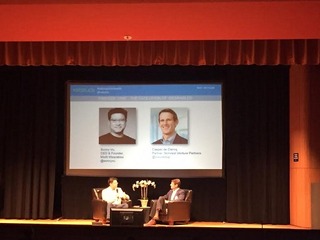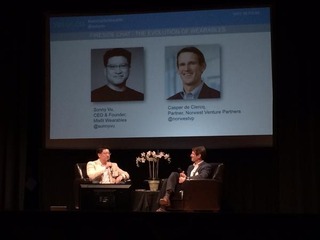
(Come mingle with hundreds of top venture capitalists representing $10B-plus in capital under management, including Khosla Ventures, Greylock and Javelin Venture Partners, and learn from founders/CEOs including Marco Zappacosta, Co-founder & CEO of Thumbtack and Adam Goldenberg, CEO of JustFab, Slava Rubin, Founder & CEO of Indiegogo, at Vator Splash Oakland on April 22nd and 23rd. Get your tickets here!)
After a few years of hearing about the coming age of wearables, suddenly that day is now upon us. And we have Apple to thank for that, of course.
In all, 19.6 million wearables were shipped in 2014, a number that will more than double, going up to 45.7 million units, in 2015, according to a report out from the International Data Corporation (IDC) on Monday. By 2019, total shipment volumes are forecast to reach 126.1 million units. That means it will have a five-year compound annual growth rate of 45.1%. Translation: you’re going to start seeing a lot more wearables very soon.
The thing that is driving this sudden burst are wearables that are “smart,” also known as those that can run third-party apps. That, of course, includes the Apple Watch, but also Motorola’s Moto 360, and Samsung’s Gear watches. They will account for 25.7 million of the wearables sold this year, up 510.9% from only 4.2 million in 2014.
So-called “basic wearables,” or those devices that do not run third party applications, will grow from 15.4 million units in 2014 to 20.0 million units in 2015, resulting in 30.0% year-over-year growth. The lesson: no one wants a wearable that doesn’t allow them to check Facebook and Twitter, access their Instagram and listen to Spotify.
To see how big of an impact the Apple Watch is going to have, take a look at how many wearables will be wrist-related. Spoiler alert: a lot of them.
In 2014, there were 17.7 million wristwear devices sold, for a 90.4% of the market, far beyond any other category. The next closest was modular devices, which are the kind that can be worn on any part of the body with a clip or a strap. Those only sold 1.6 million for 8.3%.
In 2015, wristwear devices will balloon to 40.7 million though they will lose marketshare, dropping to 89.2%. By 2019, IDC expects 101.4 million wristwear devices to be sold, for an 80.4% share. Modular devices will also drop market share in that time, going to 2.6 million and 5.7% in 2015 to 6.7 million and 5.3% by 2019.
Those two categories will lose share to clothing and eyewear, which combined for almost no units sold, and no market share, in 2014, but will together sell over 10 million units, for 8% of the market, in 2019.
Clothing devices are “expected to grow the fastest as companies embed items like shirts, socks, hats, and other products with computing power,” IDC wrote. “Eyewear is a smaller category, which IDC expects to first catch on among enterprise users within select vertical markets.”
For now, though, it will be almost all wrist wearables.
The Apple Watch
So what’s so exciting about the Apple Watch that its driving all of this activity?
There are three versions of Apple Watch; the first is simply called “Watch Sport,” and is considered to be on the low end. Apple Watch Sport will start at $349 for the 38mm version and cost $399 for the 42mm.
The next is called “Watch” and is the mid-tier version. It comes with a larger selection of bands, including leather and a link bracelet. It costs between $539 and $1049, depending on the selection of band on the smaller version; or between $599 and $1099 for the larger one.
The third is called “Apple Watch Edition” and it covers the high end of the spectrum. The Watch Edition comes with a case, clasp and bracelet that are all crafted from 18-karat gold, so this is not a product for your average wearable user. Apple Watch Edition costs $10,000.
Accurate to within 50 milliseconds of universal coordinated time, the Apple Watch comes with many different faces and configurations, including traditional and digital, as well as new and different ways, such a flower blooming, and fun ways, like a dancing Mickey Mouse.
Users can also add many details to the face they choose, such as the date, the world clock, a stopwatch, their next meeting and more. It also comes with a new feature called Glances, which allows users to check things quickly that they most frequently use. By swiping up they can see the weather, calendar, control their music and even check their heart rate.
They can also communicate in real time with other Watch users by either tapping their wrist, or by sending them drawings that they can then also watch in real time with a feature called Digital Touch. Users will be able to receive calls on the Apple Watch and read their e-mails.
Then there are the device’s health features, such as reminders to exercise, notifications if a user has been sitting long, and an update every Monday on how the previous week’s exercises went and what the user should do differently in the coming week.
It also comes with a new workout app that allow users to get detailed metrics on how their workout is going, how many calories they are burning, the distance they traveled and more.
All editions of the Apple Watch will be available for pre-order on April 10th, and users will be able to play with them in Apple Stores. The first editions of the product will ship out on April 24th.
(Image source: cultofmac.com)


















